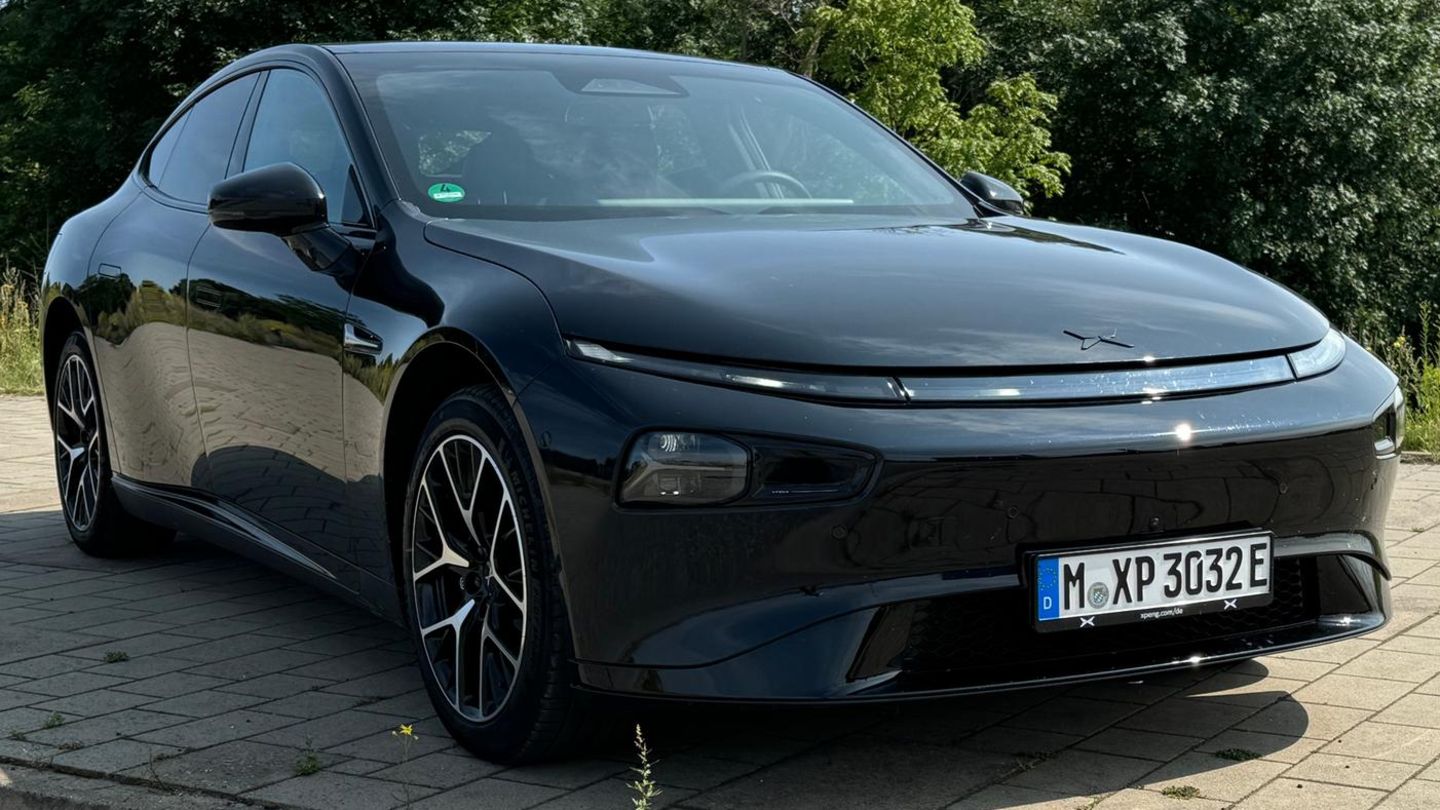With XPeng, another Chinese electric car manufacturer is pushing into the German market. The problem for the established brands: The P7 has convincing arguments.
First of all, the obvious: In the German market, the name XPeng is extremely unsuitable for an electric car. However, the name does not stand for the sound that an exploding battery makes, but is short for Xiaopeng, the name of the manufacturer from China. The relatively young company is celebrating its tenth anniversary this year and is therefore still a newcomer in the automotive industry. But that doesn’t mean anything, even Volkswagen has secured a place among the shareholders for a lot of money.
In Germany, the brand’s cars are still very rare. Currently, the G6 coupe SUV, the G9 SUV and the P7 sedan are available. The company has given the latter to the star provided for this test.
There are three models of the P7: RWD Long Range with rear-wheel drive and maximum range, AWD Performance with all-wheel drive and significantly more power and the Wing Edition, ultimately a performance model with gullwing doors and full equipment. The test vehicle is a P7 Performance with 473 hp, 86.2 kilowatt hour battery (gross), 400 volt charging technology and premium seat and audio package in “Jet Black”, a deep black metallic finish. Price: 63,460 euros.
An exemplary electric car
First, the performance: The all-wheel drive version of the P7 has 473 hp and sprints to 100 km/h in 4.1 seconds. The top speed is exactly 214 kilometers per hour, then it is limited. The chassis is quite firm, but has a comfortable touch that makes driving on uneven roads easier. The vehicle sits securely and firmly on the road and has no weaknesses. Even at over 150 km/h, the interior is still pleasantly quiet, and the insulation is good.
When driving in a relaxed manner, the battery consumes between 16 and 20 kilowatt hours per 100 kilometers. XPeng states the range as 505 kilometers (WLTP), in the real world it is probably around 450 +/- 20. That’s very decent.
Electric car
Electric car test: Xpeng P7 performance in pictures
Even if the P7 looks like a vehicle from the future on local roads, it has been around in other markets for a few years. This means that the charging technology is not quite up to date and still works with 400 volts. However, the DC charging performance is quite good. In the test, the P7 charged from 10 to 80 percent in 27 minutes at the rapid charging station, with a maximum output of 182 kilowatts. On average, the car pumped 138.8 kilowatts into the battery, but dropped sharply about halfway through the journey. At 80 percent, the P7 was still charging with 81.2 kilowatts. Not top performance, but quite good considering the technical conditions.
If you don’t want to drive manually, the car has countless sensors at its disposal. Cameras, radar and ultrasound then interact and enable the software called “XPilot” to control the car. The digital speedometer also shows what the car is detecting. It feels like the P7 doesn’t miss anything, because even the indicators of vehicles ahead are displayed correctly.
The software has some issues
So the assistance package works, but still didn’t make the best impression in the test. The driver steers surprisingly often and constantly moves back and forth within its lane. A tendency to the right-hand side of the lane means that on motorways you sometimes get uncomfortably close to trucks, which repeatedly leads to – probably unnecessary – interventions in the steering wheel. In places it seems like a small battle against the lane departure warning system, which is not the case with other manufacturers. It’s a shame that the cruise control cannot be used exclusively for distance and speed control, but only as part of the overall package with the somewhat annoying steering assistance.
Speaking of annoying: XPeng naturally complies with the applicable laws and starts beeping at one kilometer per hour too fast to warn you of speeding. Even if you slow down from 51 to 50 in town, it still flashes and beeps. It only stops at 49 km/h. It doesn’t help that the sign recognition is sometimes poor. In a test on the A7 from Neumünster to Hamburg, in perfect weather, the car interpreted the 40 km/h sign at a rest stop as the new speed limit for the motorway. As a result, annoying beeping started at 150 km/h. To put it in perspective: you can at least switch off this control for the respective journey with just two small screen gestures. Nevertheless: an update please. As soon as possible.
The same applies to the infotainment. While the hardware is extremely fast thanks to the Qualcomm chip and shows no weaknesses in terms of operation, the software seems unfinished in places and has been thrown onto the German market too hastily. The voice assistant, which doesn’t understand much, only speaks English, for example. The navigation system works quickly, but sometimes says confusing things, such as “school zone ahead”. The maps are also missing numerous destinations, especially charging stations. The good news: all of this can be greatly improved later using the software, if it happens. But XPeng can’t really leave it like that.
A real eye-catcher
Because the small weaknesses and errors tarnish the impression of an otherwise amazingly good car. As a reminder: At the beginning it was said that no other electric car had received so much praise. But that doesn’t mean the test result, but the reactions to the XPeng P7. No matter where the car appears, it rains praise. At every charging station, every bakery and even when unloading junk at the recycling center, people praise the car’s appearance and want to know more. This is quite rare for this class of vehicle – recently it has been more noticeable with cars from Rolls-Royce or Porsche.
And they’re right: the XPeng P7 is a damn beautiful car. Both the front and rear sections are extremely well done, and the continuous light strips give the car an impressive appearance. This is likely to be enhanced even more in the Wing Edition, which is available not only with gullwing doors but also in a poisonous green.
The workmanship is also impeccable. The manufacturer has no weaknesses inside or out and has produced a rock-solid car whose overall quality impression is on par with the premium segment. There could have been a little less piano lacquer in the interior – especially on the steering wheel – but apart from that, the P7 doesn’t feel cheap in the slightest.
If you book the premium seat and audio package, you also get a small concert hall from Dynaudio in the cockpit, which sounds really great. Whether you really need the many speakers, including those in the headrests, is another question. Unfortunately, there is no massage function.
The XPeng is also quite well equipped for traveling. There is plenty of space and storage in the center console, and the trunk offers plenty of room. This can be expanded even further by folding down the back seat. Unfortunately, the P7 lacks a frunk, i.e. storage space under the hood. This is annoying, because the AC charging cable is always lying around in the car and cannot be hidden in a second floor. Since the charging power at AC columns is only a measly 11 kilowatts anyway, you can just leave the cable in the garage and stick to quick chargers.
Conclusion: The XPeng P7 is a real alternative, but…
In principle, the XPeng P7 hardly has any weaknesses. And if it does, then it is in areas that can be solved remotely with a handful of updates. The car would therefore be a real alternative to popular brands such as Tesla, Smart, Kia, VW and Co. In terms of looks, the car is even in a league above its direct competitors. Prices start at 49,600 euros, with the “full package” costing 69,600 euros.
This creates two problems. Firstly, Xiaopeng is only just coming to Germany. There are currently huge gaps in the dealer network, some of them hundreds of kilometres wide. Do you live in Berlin? Too bad, your nearest dealer would be either near Hamburg or Erfurt. Are you from the beautiful Black Forest? Nearest dealers: Munich or Koblenz. Since XPeng relies on partner companies, it is only a matter of time before these gaps are closed – but as of today, it is a risk if the car does break down.
Technology is making progress
Charging stations of the future: How to finally shorten the waiting time with electric cars
Secondly, and this is exacerbated by the first problem: Even if you can get a lot of car for 50,000 to 70,000 euros, the competition in this segment is incredibly strong. Be it other Chinese brands, such as Nio or BYD, or the German manufacturers. Many have denser workshop networks and some even undercut XPeng. For example, there is the Smart #3 Brabus (tested here) or the Tesla Model 3 Long Range.
With the P7, XPeng is facing very tough competition – which the brand cannot really win without extreme discounts. But it is not the car’s fault, because it not only drives well, but is also a real eye-catcher.
Source: Stern
I’m a recent graduate of the University of Missouri with a degree in journalism. I started working as a news reporter for 24 Hours World about two years ago, and I’ve been writing articles ever since. My main focus is automotive news, but I’ve also written about politics, lifestyle, and entertainment.




